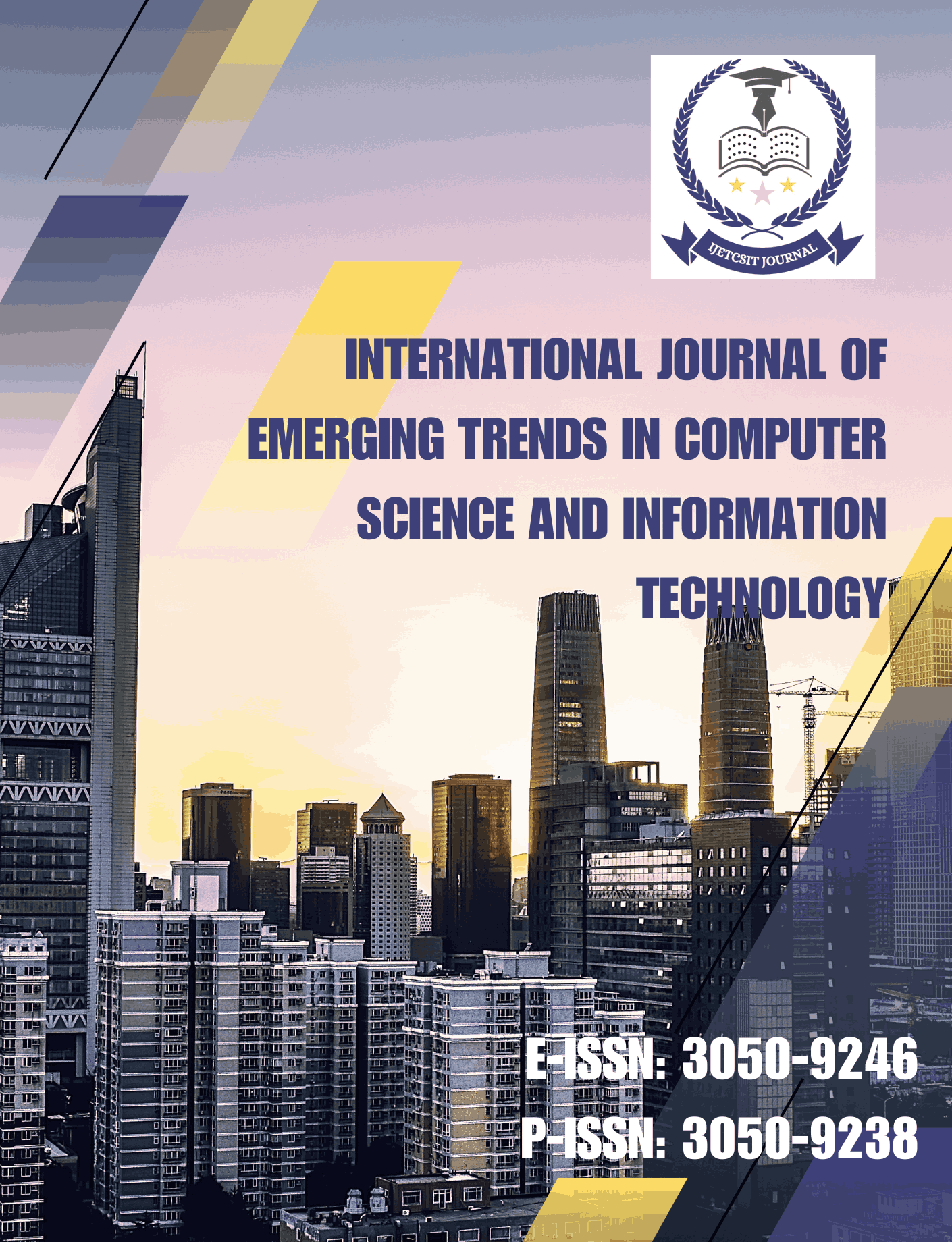Generative AI in P&C: Transforming Claims and Customer Service
DOI:
https://doi.org/10.63282/3050-9246.IJETCSIT-V5I2P113Keywords:
Generative AI, Property & Casualty Insurance, Claims Processing, Customer Service Automation, Large Language Models, Multimodal AI, AI Risk, Insurance Workflows, Fraud DetectionAbstract
Generative Artificial Intelligence (GenAI) is rapidly becoming a breakthrough in the sphere of property and casualty (P&C) insurance on two levels: claims and customer support. The current paper discusses how the idea of generative models and other AI-related approaches (large language models, multimodal generation, retrieval-augmented generation, etc.) can complement, automate, and redesign the steps in the claims lifecycle and customer interaction process. We introduce a GenAI infrastructure and approach into main P&C operations, and run emulated deployments of GenAI in claim acquisition, document processing, fraud detection, settlement bargaining, and chat-based customer support. We found that GenAI can save on turnaround time (reduction by approximately 3050) and loss adjustment costs (reduction by approximately 20) and will notice a significant increase in customer satisfaction rates. Risks, regulatory constraints, interpretability of the model and challenges of deployment are also discussed. Lastly, we discuss areas to explore in the future, such as federated learning among insurers, generation that is contract aware, multimodal damage evaluation, and trust architectures. The evidence established that generative AI can revolutionize P&C claims and service on a large scale, though it is important to consider human controls, ethical boundary, and domain adaptation
Downloads
References
[1] Bamberger, S., Clark, N., Ramachandran, S., & Sokolova, V. (2023). How generative AI is already transforming customer service. Boston Consulting Group, 6, 2023.
[2] Karri, N. (2021). Self-Driving Databases. International Journal of Emerging Trends in Computer Science and Information Technology, 2(1), 74-83. https://doi.org/10.63282/3050-9246.IJETCSIT-V2I1P10
[3] Paunov, Y., Wänke, M., & Vogel, T. (2019). Transparency effects on policy compliance: disclosing how defaults work can enhance their effectiveness. Behavioural Public Policy, 3(2), 187-208.
[4] Liu, H., & Lieberman, H. (2005, April). Programmatic semantics for natural language interfaces. In CHI'05 extended abstracts on Human factors in computing systems (pp. 1597-1600).
[5] Karri, N. (2021). AI-Powered Query Optimization. International Journal of Artificial Intelligence, Data Science, and Machine Learning, 2(1), 63-71. https://doi.org/10.63282/3050-9262.IJAIDSML-V2I1P108
[6] Hamilton, L. M., & Lahne, J. (2020). Fast and automated sensory analysis: Using natural language processing for descriptive lexicon development. Food Quality and Preference, 83, 103926.
[7] Canonico, M., & De Russis, L. (2018). A comparison and critique of natural language understanding tools. In Cloud Computing 2018 (pp. 110-115).
[8] Karri, N. (2022). Leveraging Machine Learning to Predict Future Storage and Compute Needs Based on Usage Trends. International Journal of AI, BigData, Computational and Management Studies, 3(2), 89-98. https://doi.org/10.63282/3050-9416.IJAIBDCMS-V3I2P109
[9] Androniceanu, A. (2024). Generative artificial intelligence, present and perspectives in public administration. Administration & Public Management Review, (43).
[10] Sehrawat, S. K. (2023). Transforming Clinical Trials: Harnessing the Power of Generative AI for Innovation and Efficiency. Transactions on Recent Developments in Health Sectors, 6(6), 1-20.
[11] Rahul, N. (2023). Transforming Underwriting with AI: Evolving Risk Assessment and Policy Pricing in P&C Insurance. International Journal of AI, BigData, Computational and Management Studies, 4(3), 92-101.
[12] Karri, N. (2023). ML Models That Learn Query Patterns and Suggest Execution Plans. International Journal of Emerging Trends in Computer Science and Information Technology, 4(1), 133-141. https://doi.org/10.63282/3050-9246.IJETCSIT-V4I1P115
[13] Koster, O., Kosman, R., & Visser, J. (2021, August). A checklist for explainable AI in the insurance domain. In International Conference on the Quality of Information and Communications Technology (pp. 446-456). Cham: Springer International Publishing.
[14] Kulasekhara Reddy Kotte. 2023. Leveraging Digital Innovation for Strategic Treasury Management: Blockchain, and Real-Time Analytics for Optimizing Cash Flow and Liquidity in Global Corporation. International Journal of Interdisciplinary Finance Insights, 2(2), PP - 1 - 17, https://injmr.com/index.php/ijifi/article/view/186/45
[15] Aslam, F., Hunjra, A. I., Ftiti, Z., Louhichi, W., & Shams, T. (2022). Insurance fraud detection: Evidence from artificial intelligence and machine learning. Research in International Business and Finance, 62, 101744.
[16] Karri, N., & Pedda Muntala, P. S. R. (2023). Query Optimization Using Machine Learning. International Journal of Emerging Trends in Computer Science and Information Technology, 4(4), 109-117. https://doi.org/10.63282/3050-9246.IJETCSIT-V4I4P112
[17] Saxena, A., Verma, S., & Mahajan, J. (2024). Evolution of Generative AI. In Generative AI in banking financial services and insurance: A guide to use cases, approaches, and insights (pp. 3-24). Berkeley, CA: Apress.
[18] Mishra, S., & Misra, A. (2017, September). Structured and unstructured big data analytics. In 2017 International Conference on Current Trends in Computer, Electrical, Electronics and Communication (CTCEEC) (pp. 740-746). IEEE.
[19] Settibathini, V. S., Kothuru, S. K., Vadlamudi, A. K., Thammreddi, L., & Rangineni, S. (2023). Strategic analysis review of data analytics with the help of artificial intelligence. International Journal of Advances in Engineering Research, 26, 1-10.
[20] Karri, N. (2022). Predictive Maintenance for Database Systems. International Journal of Emerging Research in Engineering and Technology, 3(1), 105-115. https://doi.org/10.63282/3050-922X.IJERET-V3I1P111
[21] Owens, E., Sheehan, B., Mullins, M., Cunneen, M., Ressel, J., & Castignani, G. (2022). Explainable artificial intelligence (xai) in insurance. Risks, 10(12), 230.
[22] Zhang, D., Yin, C., Zeng, J., Yuan, X., & Zhang, P. (2020). Combining structured and unstructured data for predictive models: a deep learning approach. BMC medical informatics and decision making, 20(1), 280.
[23] Karri, N., Pedda Muntala, P. S. R., & Jangam, S. K. (2025). Predictive Performance Tuning. International Journal of Emerging Research in Engineering and Technology, 2(1), 67-76. https://doi.org/10.63282/3050-922X.IJERET-V2I1P108
[24] Venkata SK Settibathini. Optimizing Cash Flow Management with SAP Intelligent Robotic Process Automation (IRPA). Transactions on Latest Trends in Artificial Intelligence, 2023/11, 4(4), PP 1-21, https://www.ijsdcs.com/index.php/TLAI/article/view/469/189
[25] Sehrawat, S. K. (2023). The role of artificial intelligence in ERP automation: state-of-the-art and future directions. Trans Latest Trends Artif Intell, 4(4).





